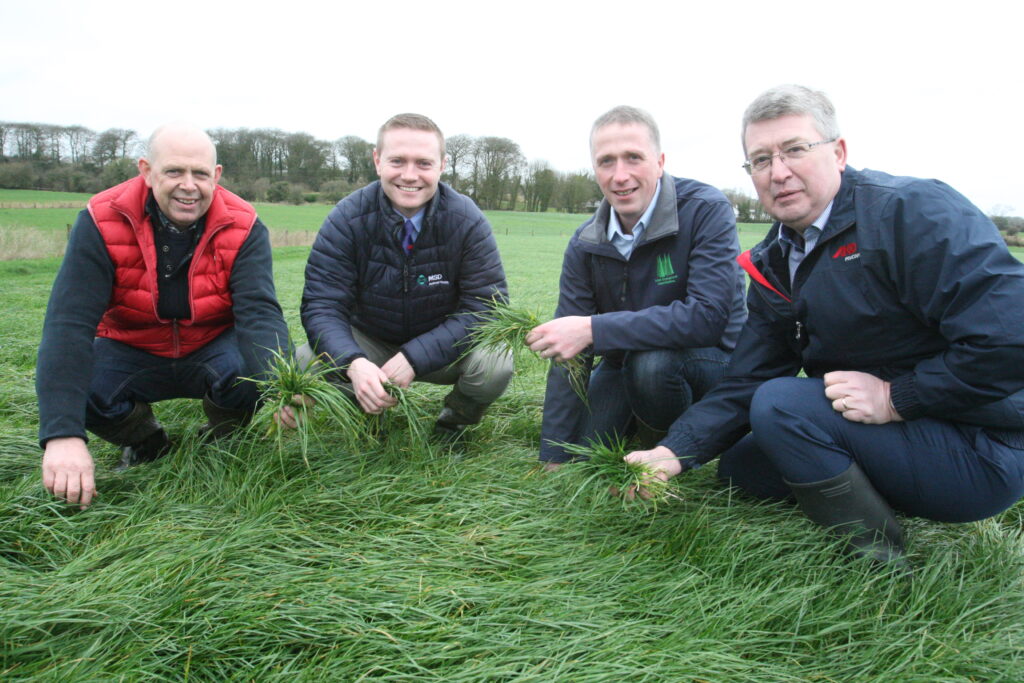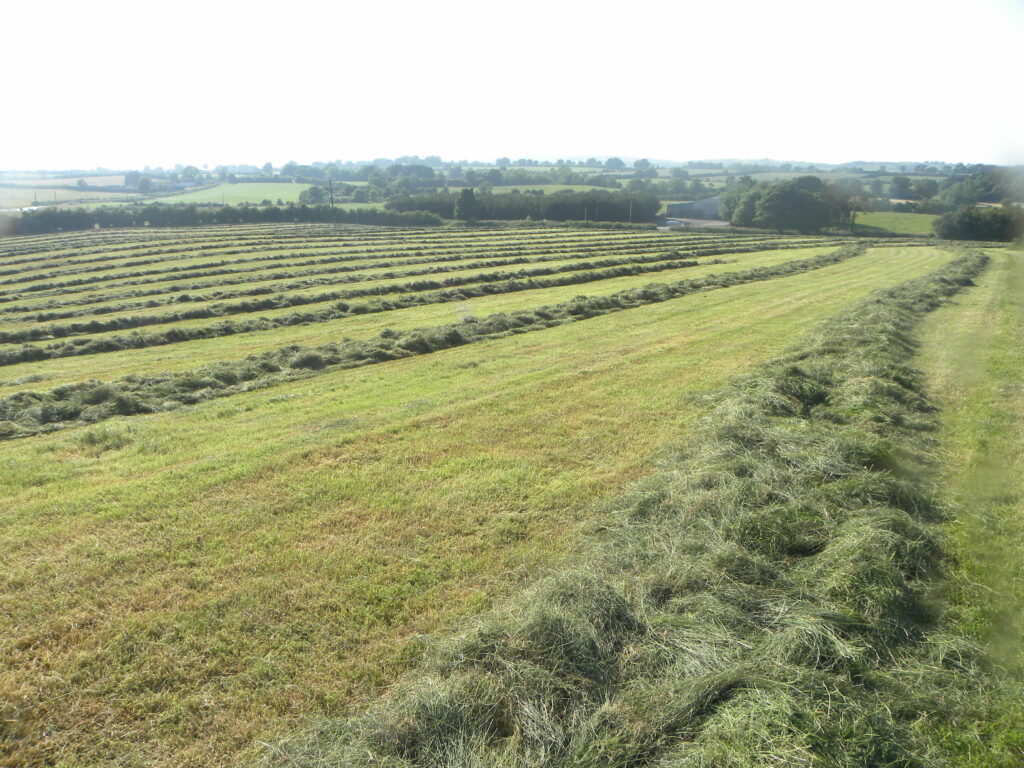John Bell farms on the outskirts of Castletown Geoghegan, Co. Westmeath, where he runs a sheep-only system on 46ha of grassland.
The Westmeath-based farmer manages a flock of 480 ewes and 130 replacements, equating to a stocking rate of 12.5 ewe/ha.
This year, the ewes on Bell’s farm scanned with a litter size of just under 2.1 lambs/ewe at a pregnancy rate of 98%.
This high performance is carried through to weaning, with the ewe flock delivering in excess of 1.7-1.8 lambs reared per ewe joined on a consistent basis.

Photo l-r: John Bell, host farmer; William Minchin, MSD; Bernard Ging, Irish Grassland Association President; and Francis Mann, Mullinahone Co-op
Swapping meal for grass
The farm itself is laid out in one block on a combination of dry and more peat-type soil, which John will admit has its pros and cons depending on the time of year and weather conditions.
Good grassland management is now at the fore of John’s system, but this has not always been the case, with the farm heavily reliant on concentrates in the past.
It was after completing an e-Profit monitor with his advisor David Webster that it was confirmed and laid bare what John already knew; far too much of his profits were being swallowed up in escalating meal bills.
Rather than keep doing what he had always done, John took the necessary steps to address the issue and stepped up his grassland management game.
A focus on grazing infrastructure
With good levels of soil fertility, grazing infrastructure was the first port of call.
Larger areas on the farm were divided, making good use of the TAMS grant to achieve some of the permanent divisions.
Temporary fencing was then, and still is, used to good effect to achieve further divisions and this has provided an economical way to achieve further progress in grassland management.
John puts a bit of thought and practical experience into his system and came up with his own method of deploying these fences – to leave the process easier.
The increased number of divisions allows John to more effectively manage grass, reduces the residency period and increases overall grass production and utilisation.
Concentrate and winter feeding
Since becoming more focused on grass, John has also changed the meal feeding programme on his farm.
Now concentrate feed is only introduced in late August, starting with the ram lambs first and gradually spreading to the remaining lambs in September.
This has led to a dramatic reduction in the farm’s meal bill and an increase in overall profits. John will admit himself that he was feeding lambs to sell them into a falling market, as opposed to drafting them off the grass his farm was capable of producing.
Winter feed is produced in the form of pit silage, with excess grass being harvested in the form of round bales.
This fulfills another aim of keeping the system simple with silage dispensed via a Lucas blower along the feeding barrier. It helps to keep labour input to a minimum.
The mature ewe flock is the first to be housed, with the ewe lambs kept out for longer to clean out paddocks. Overall labour input is kept low with help drafted in only at lambing and at key stages of the year.
Breeding programme
When it comes to breeding, animal performance is key. All lambs produced on the farm are finished or retained as replacements.
On the terminal side, high-index Texel, Charollais and Suffolk rams make up the team. Belclare rams are also used to breed replacements in a criss-cross programme with the terminal sires on the farm.
Key to the performance on John’s farm is his high-output ewe flock and, given the numbers, his aim is to achieve a high-output ewe that will look after herself and her lambs.
The ewe flock lambs from early March onwards and consists of a mixture of maternal and terminal genetics.
Spring management
Post-turnout the majority of the ewes (i.e. rearing twins) are split into four grazing groups, which are later reduced to two as the season progresses.
Ewes rearing triplets are kept separate and offered supplementation for a number of weeks post-lambing, to help maintain condition and boost milk yield.
Unlike a lot of systems lambs are not offered creep. Again, John feels the combination of good grassland and productive ewes should be capable of achieving high levels of lamb performance.
Breeding ewe lambs
To further increase output, all ewe lambs are joined each year with Charollais rams. These lamb at the end of March when the pressure is reduced.
John traditionally only retained the pregnant ewe lambs, as he believes these are the more productive replacements – when you examine the performance there may be merit to this.
These yearling ewes had a scanned litter size of 1.6 with a pregnancy rate of 82% after a joining period just shy of three weeks. Due to the shorter joining period, John has retained the empties this year.
Yearlings rearing twins are kept separate for a number of weeks and offered supplementation before rejoining their counterparts.
Similar to the situation with the triplet ewes, no creep is offered to the lambs produced.
Key features of John’s system
The key features in John’s system that are clear to anyone who visits the farm are keeping management straightforward and simple and focusing on the factors you can manage.
Combine grass, genetics and good management and you can achieve your targets, he says.
As part of the upcoming Irish Grassland Association Sheep Conference and Farm Walk, which will be held on May 11, John will open the gates of his farm to let delegates see his system first-hand. Click here for full details on the IGA Conference and Farm Walk


